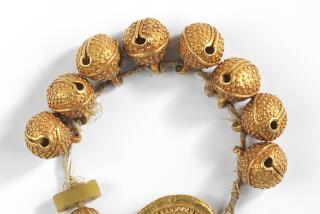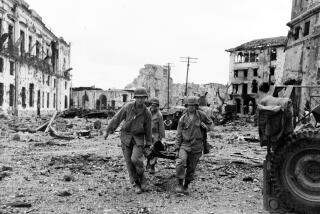Dispute Over Bells Taking Toll on U.S.-Filipino Relations
CHEYENNE, Wyo. — A hundred years has not silenced the patriotic fervor between the United States and the Philippines over the Bells of Balangiga.
Many American veterans say the bronze church bells on the grounds of F.E. Warren Air Force Base here memorialize 46 soldiers who were massacred by Filipino insurgents on Sept. 28, 1901.
Filipinos see the two bells as symbols of the beginning of the end of a centuries-long pursuit of independence, not unlike how Americans regard the Liberty Bell.
With the centennial of the massacre on Friday, the Philippines’ request to return the war trophies remains a touchy diplomatic issue between nations that otherwise are friends.
Officials at the air base say it is a matter only Congress can resolve.
But with the world shaken by the attacks on the World Trade Center and the Pentagon, and the United States embarking on a war against terrorism, a resolution any time soon seems more unlikely than ever.
Former Philippines President Fidel Ramos recalled trying to work out an answer with then-President Clinton in 1998.
“The win-win formula I suggested is not for one bell to be sent here and one bell to be retained in Wyoming. I said, ‘We will cut the bells in half. You keep two halves and you send back to us two halves and then we rebuild them as best as we can. And then we end up with two pairs that are almost identical to the original,’ ” Ramos recalled.
He said Clinton liked the idea, but no action was taken. And plenty of veterans in Wyoming are opposed.
“Folks that are of the feel-good, do-good, wouldn’t-it-be-nice type think that we should give a lot of these things back,” said retired Col. Dave McCracken, who was commander of F.E. Warren in the early 1980s.
“That’s not how a conservative military guy thinks.”
The United States acquired the Philippines after the Spanish-American War in 1898. When that did not mean independence after 377 years as a Spanish colony, Filipino Gen. Emilio Aguinaldo turned against his American allies.
Resistance continued despite Aguinaldo’s capture on March 25, 1901.
That summer, American troops were sent to tiny Balangiga on the backwater southern coast of Samar. After several uneventful weeks the scene was set for an episode that would be unparalleled in the Philippine-American War, according to Brian McAllister Linn, a Texas A&M; University history professor who has spent 20 years researching the war.
On the night of Sept. 27, several women carrying small coffins were seen hurrying to the village church and were stopped. A sergeant looked inside one coffin and was told the child inside had died of cholera.
He let them pass without noticing that the coffin also contained bolos--large knives--and that the women were not really women.
Four days after the attack, a report by 9th Infantry Capt. Edwin V. Bookmiller fingered local Chief of Police Pedro Sanchez as the instigator of the assault at 6:20 a.m. Sept. 28.
“As the sentinel passed him, he seized the sentinel’s rifle, gave a loud call, the church bells rang and a rush was made by the natives simultaneously on the different barracks, officers’ quarters and on men at the breakfast table and kitchen,” Bookmiller wrote.
He estimated the attacking force at 400. Company C tried to fend off the attackers with kitchen utensils, chairs, cans of food and anything else on hand. They made a run for the rifles and reached some before the rebels.
Those who made it to five canoes on the shore of Samar faced a grueling, 25-mile paddle up the coast. Three canoes swamped and some men drowned. Others succumbed to their wounds along the way.
The next day, Company G, 9th Infantry, steamed back down the coast on the USS Pittsburgh. The soldiers retook Balangiga and burned the village to the ground.
What happened over the next three months is much debated. Filipinos sometimes claim that the Americans killed tens of thousands, possibly hundreds of thousands, of their countrymen in retribution.
Linn doubts the number was nearly that high, citing U.S. Army records that say 759 rebels were killed or captured.
“I don’t understand why people keep using this term ‘killing thousands,’ ” he said. “It’s not found in the American sources and it’s not found in the Philippine sources. It’s not found in the writing.”
What is undisputed is that, once back home, Gen. “Howling” Jake Smith was court-martialed for an order to spare no one over age 10.
Marine commander Major Littleton Waller said Smith put it to him this way: “I want no prisoners. I wish you to kill and burn; the more you kill and burn, the better it will please me.”
Smith did not contest the charges against him. He was convicted and admonished and soon retired. Waller was also court-martialed. He said he was just following orders and was acquitted.
At the center of F.E. Warren Air Force Base, antelope graze near Trophy Park, where a crescent-shaped monument of crumbling brick holds the Bells of Balangiga. A glass case nearby houses the 444-year-old British Falcon cannon that was also taken from the village.
It was the 9th Infantry that was attacked in Balangiga, but it was the reoccupying 11th Infantry that took the bells and the cannon home to Wyoming in 1904. The oldest continually used Air Force installation, F.E. Warren oversees 50 Peacekeeper and 150 Minuteman missiles in three states.
The plan most often talked about for resolving the debate over the bells is to duplicate them. Each nation would keep an original and a replica.
“I say let’s give one back,” said Nelinda Evaristo-Dahmke, of Sheridan. She is one of Wyoming’s few citizens of Filipino descent. (The U.S. Census puts the number at 472.)
“Giving one back doesn’t take a position that what we did as a government was wrong. To me it says we have developed, we have progressed since then,” she said.
Bishop Joseph Hart of the Roman Catholic diocese in Cheyenne and Bishop Leonardo Y. Madroso, his counterpart in the Diocese of Borongan on the island of Samar, have also campaigned for the bells’ return.
“The whole thrust of my interest is that these two bells are religious articles,” Hart said. “They belong to the church and as such they should not be trophies of war.”
Most Wyoming veterans wish the debate would end and that the bells would stay put.
“The bells have been kind of abused and accused again in a manner like when they were used to signal the attack,” McCracken said. “It should not be an issue any longer.”
Robert Nab, who served in the U.S. Navy during World War II, said most of his fellow American Legion members in Cheyenne believe the bells are legitimate war trophies.
Veterans outside Wyoming seem less convinced. AMVETS and American Legion members voted at national meetings in favor of copying the bells and each side keeping an original and a replica.
“It’s something that the government can resolve,” said Legion national spokesman Joe March. “A reasonable disposition is attainable. There should be reasonable minds on both sides. With the intervention of Congress and the administration, something should be worked out.”
More to Read
Sign up for Essential California
The most important California stories and recommendations in your inbox every morning.
You may occasionally receive promotional content from the Los Angeles Times.










